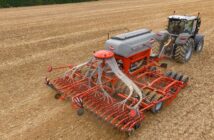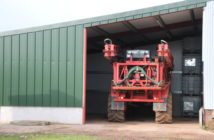Technological updates announced by KUHN Farm Machinery in relation to its forage and straw baling equipment are all designed to improve control of product quality and/or operational efficiency.
Humidity sensor to help achieve optimum dry matter
KUHN’s VB variable chamber balers and VBP BalePack variable chamber baler-wrapper combinations are now available with the option of a humidity sensor. This device can measure forage composition up to a level of 40% moisture, providing a useful way to monitor a crop’s suitability to hit a target dry matter. The humidity sensor is available on all models in the VB and VBP ranges from 2021 and will be retrofittable onto 2021 machines and beyond.
VB balers and VBP Balepack baler-wrapper combinations are equipped with KUHN’s progressive density baling chambers and are suitable for handling a range of wet and dry crops: from hay and straw (5-20% moisture), to haylage (18-35% moisture) and silage (35-80% moisture).
From 2020, the VBP BalePack has been available with KUHN’s award-winning film binding system as an alternative to net binding. This system has been successfully deployed over several years on the FBP BalePack and the compact i-BIO baler-wrapper combination.
Bale weighing for production monitoring
A bale weighing system is being launched as an option on KUHN’s FBP BalePack and VBP BalePack baler-wrapper combinations, from 2021 onwards. Mounted on the wrapping table, this technology weighs each bale and provides a rolling average of the previous three bales, allowing an estimation of total production of forage or straw.
Intake control and consistent output
Technological developments on KUHN’s SB square baler range include an adaptation of the pick-up to improve intake and an expansion of the bale channel to increase the consistency of bale density.
At the intake end, the new power feed roller actively follows the height of the swath and the overall tine-to-tine width within the pick-up has been increased. This improves the consistency of crop flow to the rotor, removing peaks in power demand and reducing the risk of blockages.
At the output end, the bale channel length is now 375cm and includes a total of nine cylinders. This ensures consistency in bale density, particularly when baling very dry material.




